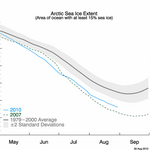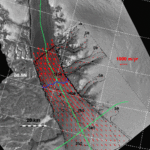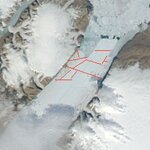Oceanography

Petermann's Progress
The huge ice island which calved from Petermann Glacier on August 4th was stuck in the mouth of Petermann Fjord for quite some time. As I had suggested, it did not get into Nares Strait as a single ice island. It broke into two main parts: Petermann 2010-A and Petermann 2010-B
Petermann Ice Island 2010-B
Petermann 2010-B moved at a fairly rapid rate along the strait. There are many wind and surface current eddies, so it appeared to me to be likely that Petermann 2010-B would ground itself if it moved inshore enough. I overlooked two factors which…

Petermann Ice Island - Now There Are twoPetermann Ice Island (2010) has now broken into two parts. The smaller island is about 80 km2. It is the thinner of the two and is likely to melt away first. Based on the labels already in use in comments1, I shall designate the larger island as Petermann 2010-A and the smaller one as Petermann 2010-B.
Petermann Ice Islands A and Bimage source: http://ocean.dmi.dk/arctic/images/MODIS/Kennedy/201009091609.ASAR.jpg
The importance of the Petermann Glacier calving to climate science is not so much that it happened, but that it was…

Arctic Ice September 2010 - Update #1
This is my first update to Arctic Ice September 2010.
As the Arctic melt season draws to a close there are still a very few people writing about recovery. A trend towards recovery would be a reversal over at least a decade of all current Arctic ice loss trends. A reversal would show ice becoming older, thicker and less mobile on average year-on-year. In fact, the trend is clear: the ice is becoming younger, thinner and more mobile year-on-year. If that trend continues - and I can see no reason why it should not - then we shall soon…

The Greenland and West Antarctic ice caps are melting at half the speed previously predicted, shows a team from the Jet Propulsion Laboratory, Delft University of Technology (TU Delft, The Netherlands) and SRON Netherlands Institute for Space Research in Nature Geoscience.
The melting of the ice caps has been charted since 2002 using the measurements produced by the two GRACE satellites. From space they detect small changes in the Earth's gravitational field and these changes are related to the exact distribution of mass on Earth, including ice and water. When ice melts and lands in the sea,…

Arctic Ice September 2010
As I write these words - September 01 2010 - Arctic sea ice extent as reported by NSIDC and JAXA is not as low as I had expected it to be.
image source: http://nsidc.org/arcticseaicenews/.The IARC-JAXA graph shows 2010 extent as 4th lowest of recent years thus far, behind 2007, 2008 and 2009.
image source: http://www.ijis.iarc.uaf.edu/en/home/seaice_extent.htm.This detail, with a magenta horizontal lime added, shows the lowest extents more clearly:
My last two forecasts of sea ice extent over-estimated the extent loss. What went wrong? The year started…

Arctic Ice August 2010 - Update #3
The NSIDC has just issued an update report for August -
August 17, 2010North by NorthwestThe end of summer is approaching in the Arctic; temperatures are dropping and melt is ending in the high latitudes. Yet summer is not quite over in the lower latitudes of the Arctic Ocean, where sea ice extent continues to decline. Sea ice has melted out extensively in the northern route of the Northwest Passage, but the passage is not completely open.Meanwhile, in the Antarctic, sea ice extent continues to be well above normal, largely because of atmospheric…

Arctic Ice August 2010 - Update #2
Since I last posted an update, many things have happened in the Arctic and sub-Arctic.
In my last update - Arctic Ice August 2010 - Update #1 - I noted that there were no floes in the main pack bigger than 35km2. I invited my readers to find a floe bigger than that anywhere in the main ice pack. Nobody did. Yes, there were a few bigger floes - even big enough to be called ice islands - but they were not in the main pack.
The more fragmented the main pack is, the less likely it is that floes will over-ride each other and form thick sheets.…

Petermann Glacier Calving 2010 - Update
Before I discuss the recent calving of the Petermann Glacier ice tongue, I want to give credit to the many scientists who were studying, predicting and observing this event. If I miss anyone out, please advise by email or comment and I will edit this article accordingly.
The scientists who deserve credit, in no particular order:
Humfrey Melling at DFO submitted a detailed science article to the Journal of Geophysical Research - Oceans just a few weeks before the event, and so missed the chance of including the calving in his article.
Luc…

The Anatomy Of A DiscoveryPetermann Glacier Ice Tongue Calving 2010
Science20.com is a science site.
Now, I could blabber and bluster about how I once advised Margaret Thatcher1. Which I did. In a private letter which was answered by the Iron Lady herself in her own handwriting. I had further communication with her via my local M.P. - the politician, not the policeman! All of which has nothing whatsoever to do with my reputation in the science community. Nor should it.
Science20.com is a science site.
It is exactly because this is a science site that I want you…

Arctic Newsflash! Petermann Ice Tongue Loses Huge Chunk
I have been watching the Petermann Glacier ice tongue for some time now.
Here is what I wrote in Arctic Ice July 2010 - Update #3:
Judging from historic maps and images, the normal behavior of the Petermann ice tongue was the formation of a concave front at the fjord mouth. Over recent years it has retreated. Much of the tongue is now detached from the walls of the fjord. Tidal forces will flex the tongue up and down: wind, currents and ice floe impacts will all exert at least a small lateral force on the tongue.…